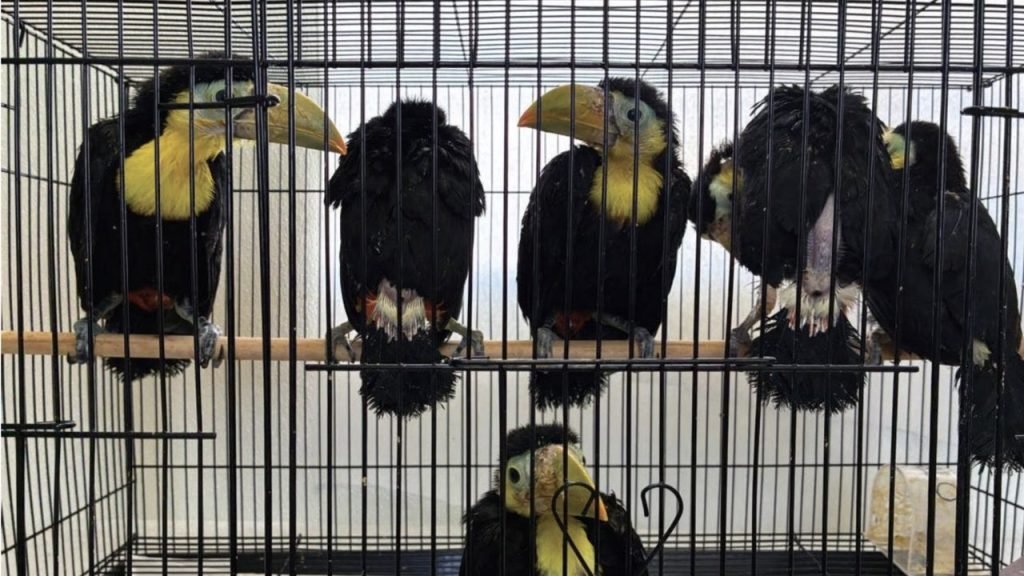A San Ysidro Man Charged with Smuggling 14 Exotic Toucans Across the U.S.-Mexico Border
The cramped darkness of a car’s dashboard harbored a secret, one that would soon be exposed in a chilling reveal at the Otay Mesa Port of Entry. Custom officials uncovered a heartbreaking scene on June 25 when they discovered 14 juvenile Keel-billed toucans, bound and sedated, hidden beneath the vehicle’s interior. What transpired next would expose a disturbing trend in wildlife trafficking that threatens not only endangered species but also global health.
A Daring Attempt
The driver, a 35-year-old San Ysidro man, faced serious charges that day, including smuggling and illegal importation of protected wildlife. The U.S. Customs and Border Protection (CBP) agents had become increasingly adept at detecting such nefarious activities, but every success underscores a growing concern in the realm of wildlife trafficking.
A specially trained CBP dog alerted its handler to the suspicious Volkswagen Passat, prompting a thorough inspection. Officers were initially baffled when they discovered one of the birds, its movements hinting at its distress, wrapped in cloth and duct tape beneath the dashboard.
The Discovery and Its Implications
Upon further investigation, officers pried open a side panel and uncovered 13 additional toucans, all similarly restrained. What was first perceived as a bizarre and cruel smuggling operation quickly evolved into a fundamental question: what drives an individual to engage in such illegal wildlife trade?
- Exotic species command high prices on the black market, with Keel-billed toucans ranging up to $5,000 each.
- This opportunistic behavior emerges from socio-economic pressures in the region.
- Wildlife trafficking poses not only ethical dilemmas but also health risks originating from potential zoonotic diseases.
“The black market for exotic wildlife thrives on ignorance and a lack of resources in affected countries,” said Dr. Melissa Gomez, a wildlife ecologist at the Arcadia Institute. “This case is a glaring example of how desperation can lead to the exploitation of nature for profit.”
The Response from Authorities
Following the discovery, officials from the U.S. Fish and Wildlife Service quickly intervened. These juvenile Keel-billed toucans, native to regions between southern Mexico and Ecuador, are protected under the Convention on International Trade in Endangered Species (CITES). This means that their trafficking contravenes international wildlife preservation efforts, adding layers of complexity to an already fraught issue.
Veterinary services assessed the birds—some suffered severe injuries, including broken tails and legs, while others bore the physical and psychological scars of being confined in such a brutal manner. Nevertheless, reports indicate that all birds are expected to survive.
“This alarming incident highlights the urgent need for more stringent enforcement of wildlife protection laws,” commented Ben Roberts, executive director of the Global Wildlife Defense Initiative. “Moreover, it shines a light on the connection between wildlife trafficking and broader health risks, as these birds could potentially carry diseases like avian influenza.”
Health and Ecological Concerns
The potential repercussions of trafficking exotic wildlife extend beyond the immediate harm to the animals involved. The smuggling of birds across borders bypasses vital quarantine measures, placing entire ecosystems at risk. As Dr. Jenna Lin, a conservation biologist, notes, “In the interconnected world we live in, the consequences of such actions reverberate beyond the individual instance. The potential for disease transmission cannot be overstated.”
Studies on wildlife trafficking show alarming trends. According to a 2021 report from the International Union for Conservation of Nature (IUCN), wildlife trafficking contributes to a staggering decline in biodiversity, with some species teetering on the brink of extinction due to such practices. The intersection of social dynamics, poverty, and profit creates a perfect storm for wildlife exploitation.
Future Implications
This specific case in San Ysidro reflects not only the gravity of the illegal wildlife trade but also the need for a comprehensive response to mitigate its future occurrence. As researchers continue to analyze the implications of these smuggling incidents, there is burgeoning support for the reinvigoration of laws surrounding wildlife trafficking.
In response to these pressing issues, various conservation groups are advocating for enhanced public awareness campaigns, stricter border control measures, and international collaboration to bolster wildlife protection laws globally. The U.S. government has even proposed revising current wildlife regulations to address loopholes in enforcement tactics.
Moreover, the involvement of local communities in conservation efforts emerges as a significant approach. Educational programs aimed at minimizing economic dependency on the trafficking of endangered species show promise in altering behavior and fostering alternative livelihoods.
As the case draws to a close in a legal sense, the echoes of these sentient beings—the toucans—remain resonant. Their survival story, while compelling, unveils a complex narrative about the human-Wildlife relationship and the devastating impacts of exploitation fueled by greed and desperation. Awareness must translate into action, for without a concerted effort to tackle such heinous acts, all we will have left of these magnificent creatures are memories encapsulated in vivid encounters across rainforests and our dwindling natural world.









